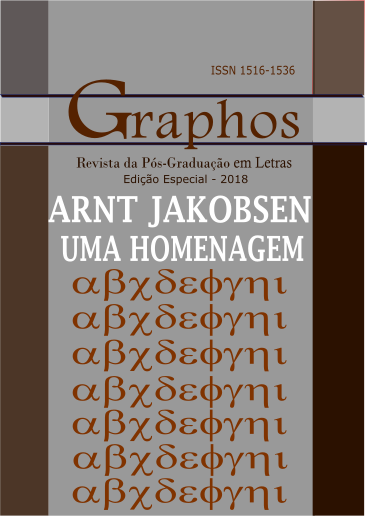As mudanças no percurso do olhar (gaze) são indicativas da segmentação textual do tradutor?
Palavras-chave:
Pesquisa do processo tradutório, Segmentação, Mudanças na atenção, Unidades de atenção, Unidades de processamento, Unidades de tradução, Rastreamento ocularResumo
O registro dos acionamentos de teclas e mouse (key logging) demonstra que a produção textual do tradutor pode ser decomposta em unidades delimitadas por fronteiras de pausas (DRAGSTED, 2004, 2005, 2010). Em contrapartida, pesquisas sobre leitura não identificaram fronteiras análogas, visto que as únicas interrupções na atenção visual do leitor consistem, na maioria das vezes, somente em piscadelas de olhos. No entanto, em um experimento envolvendo o rastreamento dos movimentos do olhar de um tradutor em uma tela que apresentava o texto-fonte e o texto-alvo (em processo de produção), os dados do olhar (gaze) mostraram mudanças na atenção visual do tradutor entre os dois textos. Será que tais mudanças podem ser vistas como um indicador de unidades de processamento de conteúdo? Será que tais mudanças nos fornecem informações mais precisas sobre a segmentação ou, pelo menos, são mais informativas que os intervalos nos acionamentos de teclas e mouse? Usando, a título de ilustração, um registro com baixa qualidade de calibração de apenas uma tradução de uma única sentença (extraída de uma tarefa maior), este trabalho tem por objetivo (i) explorar a possibilidade de se identificar segmentos – entendidos como unidades de processamento – com base nas mudanças do percurso do olhar e (ii) investigar o que motiva tais mudanças. Esta pesquisa também busca mostrar em que medida a nossa interpretação das representações do olhar (gaze), ainda representações não ideais, dependem de uma teoria da leitura.
Downloads
Referências
ALVES, F.; VALE D. Probing the unit of translation in time: aspects of the design and development of a web application for storing, annotating, and querying translation process data. Across Languages and Cultures, v. 10, n. 2. p. 251-273, 2009.
ANGELONE, E. Uncertainty, uncertainty management and metacognitive problem solving in the translation task. In: SHREVE, G.; ANGELONE, E. (Ed.). Translation and cognition. Amsterdã: John Benjamins, 2010. p. 17-40.
BADDELEY, A. D. Working memory. Oxford: Clarendon Press, 1986.
BALLING, L. W.; HVELPLUND, K. T.; SJØRUP, A. C. Evidence of parallel processing during translation. Meta, v. 59, n. 2, p. 234-259, 2014.
BUTTERWORTH, B. Evidence from pauses in speech. In: BUTTERWORTH, B. (Ed.). Language production: speech and talk. Londres: Academic Press, 1980. p. 155-176.
CARL, M.; KAY, M. Gazing and typing activities during translation: a comparative study of translation units of professional and student translators. Meta, v. 56, n. 4, p. 952-975, 2011.
CARL, M.; DRAGSTED, B. Inside the monitor model: processes of default and challenged translation production. Translation: Corpora, Computation, Cognition, v. 2, n. 1. p. 127-145, 2012.
CHESTERMAN, A. Readings in translation theory. Helsinki: Finn Lectura, 1989.
DE GROOT, A. M. B. The cognitive study of translation and interpretation. In: DANKS, J. H.; SHREVE, G. M.; FOUNTAIN, S. B.; MCBEATH, M. K. (Ed.). Cognitive processes in translation and interpreting. Londres: Sage Publications, 1997. p. 25-56.
DRAGSTED, B. Segmentation in translation and translation memory systems. an empirical investigation of cognitive segmentation and effects of integrating a TM system into the translation process. 369 f. 2004. Tese (Doutorado) – Copenhagen Business School, Copenhagen, 2004.
DRAGSTED, B. Segmentation in translation: differences across levels of expertise and difficulty. Target, v. 17, n. 1, p. 49-70, 2005.
DRAGSTED, B. Coordination of reading and writing processes in translation: An eye on uncharted territory. In: SHREVE, G.; ANGELONE, E. (Ed.). Translation and cognition. Amsterdã: John Benjamins, 2010. p. 41-62.
DRAGSTED, B. I.; HANSEN, G. Comprehension and production in translation: a pilot study on segmentation and the coordination of reading and writing processes. Copenhagen Studies in Language, v. 36, p. 9-29, 2008.
GOLDMAN-EISLER, F. Pauses, clauses, sentences. Language and Speech, v. 15, n. 2, p. 103-113.
IMMONEN, S.; MÄKISALO, J. Pauses reflecting the processing of syntactic units in monolingual text production and translation. Hermes – Journal of Language and Communication Studies, v. 44, p. 45-61, 2010.
IVIR, V. Formal correspondence vs. translation equivalence revisited. Poetics Today v. 2, n. 4, p. 51-59, 1981.
JAKOBSEN, A. L. Effects of think aloud on translation speed, revision, and segmentation. In:
ALVES, F. (Ed.). Triangulating translation: perspectives in process oriented research. Amsterdã: John Benjamins, 2003. p. 69-95.
SCHILPEROORD, J. It’s about time: temporal aspects of cognitive processes in text production. Amsterdã: Rodopi, 1996.
TIMAROVÁ, S.; DRAGSTED, B.; GORM HANSEN, I. Time lag in translation and interpreting. In: ALVSTAD, C.; HILD, A.; TISELIUS, E. (Ed.). Methods and strategies of process research: integrative approaches in Translation Studies. Amsterdã: John Benjamins, 2011. p. 121-146.
TIRKKONEN-CONDIR, S. The monitor model revisited: evidence from process research. Meta, v. 50, n. 2. p. 405-414, 2005.







